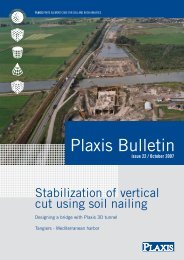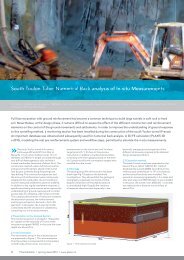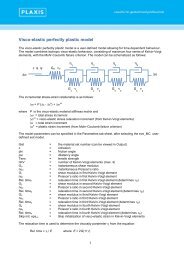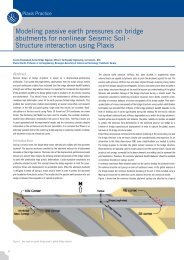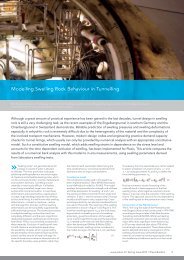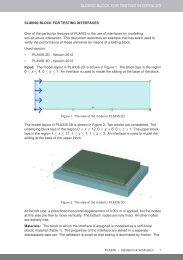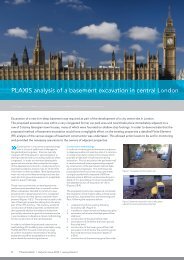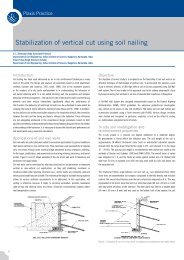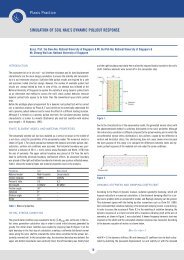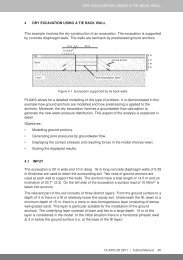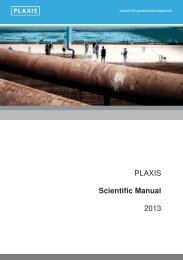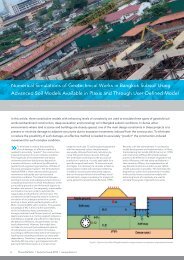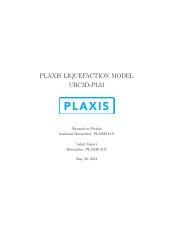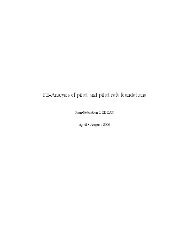Nicoll Highway Collapse: Evaluation of Geotechnical ... - Plaxis
Nicoll Highway Collapse: Evaluation of Geotechnical ... - Plaxis
Nicoll Highway Collapse: Evaluation of Geotechnical ... - Plaxis
You also want an ePaper? Increase the reach of your titles
YUMPU automatically turns print PDFs into web optimized ePapers that Google loves.
significant reductions in pore pressures should occur in the Old Alluvium. The magnitude <strong>of</strong> pore<br />
pressure change can be estimated using the well known Skempton pore pressure parameters, A and B:<br />
Δu = BΔσ 3 + AB(Δσ 1 -Δσ 3 ) (2)<br />
where Δσ 1 and Δσ 3 are the changes in (major and minor principal) total stresses due to the excavation<br />
(the ratio Δσ 3 / Δσ 1 will depend on the depth to width <strong>of</strong> the excavation, for a very wide excavation 1-<br />
D generate Δσ 3 = 0 and Δσ 1 = Δσ v ). For saturated soils, it is generally assumed that B = 1.0 while the<br />
parameter A depends on soil shear properties. For elastic unloading, A = 0.5, hence the change in pore<br />
pressure expected beneath the center <strong>of</strong> the excavation Δu ≤ 0.5Δσ v .<br />
Partial drainage within the Old Alluvium can be evaluated directly by monitoring pore pressures<br />
within the Old Alluvium. Unfortunately, there was only one piezometer installed beneath the excavation<br />
within the weathered OA material in the M3 area (GWV-24 located close to the north diaphragm<br />
wall at 64mRL). This device measured Δu = 0.25 – 0.30Δσ v (where Δσ v is the 1-D vertical stress relief)<br />
for excavation to 82 mRL (i.e, to strut level 6, Fig. 1), but was ineffective thereafter. Finite element<br />
simulations <strong>of</strong> these data are consistent with the assumption <strong>of</strong> undrained conditions.<br />
3 ANALYSIS OF SOIL-STRUCTURE INTERACTION<br />
3.1 Method and Assumptions<br />
The design <strong>of</strong> the lateral earth support system for Contract 824 was based directly on results <strong>of</strong> nonlinear<br />
Finite Element (FE) analyses using the <strong>Plaxis</strong> program (v7.2). This program is capable <strong>of</strong> modeling<br />
response <strong>of</strong> the continuous ground mass (deformations and groundwater seepage) and interactions<br />
with the structural support elements (perimeter wall, preloaded cross-lot struts) in two dimensions.<br />
At each stage <strong>of</strong> a simulated construction schedule, the numerical analyses generate information<br />
on the bending moments and deflections <strong>of</strong> the perimeter diaphragm wall, axial strut forces, ground<br />
deformations and pore pressures. By representing the complex stress changes within the soil mass<br />
during an excavation (arching mechanisms etc.), 2-D FE programs such as <strong>Plaxis</strong> represent a major in<br />
advance in analysis capabilities compared to conventional 1-D (FE) models <strong>of</strong> support systems (e.g.,<br />
Wallap, Geosolve, 2002; Kasetsu-5x, CRCRI, 1999). However, effective utilization <strong>of</strong> these capabilities<br />
requires: a) careful specification <strong>of</strong> boundary and initial conditions (in situ soil stresses and<br />
groundwater conditions), b) selection <strong>of</strong> soil models with appropriate input parameters to represent engineering<br />
properties <strong>of</strong> the pertinent soil layers (shear strength, stiffness parameters and permeability);<br />
and c) methods for interpreting and evaluating predictions <strong>of</strong> the analyses. There also remains a major<br />
question regarding the appropriate use <strong>of</strong> finite element methods in the design <strong>of</strong> excavation support<br />
systems particularly in the definition <strong>of</strong> ‘worst credible’ or ‘moderately conservative’ ground (soil and<br />
groundwater properties) and loading conditions (as discussed by Simpson & Yazdchi, 2003).<br />
The default mode <strong>of</strong> calculation used by <strong>Plaxis</strong> treats soil as a two phase medium comprising the<br />
soil skeleton and interstitial pore water (it is also possible to model single phase, ‘non-porous’ materials).<br />
The <strong>Plaxis</strong> program follows conventional geotechnical design calculations which assume simplified<br />
drainage conditions (i.e., flow <strong>of</strong> groundwater) within soil layers. Low permeability clays are<br />
treated as undrained materials (i.e., there is no migration <strong>of</strong> pore water within the skeleton over the<br />
time frame <strong>of</strong> interest), while more permeable sands are considered fully drained (i.e, pore pressures<br />
are always in a steady state condition - as groundwater flow can occur rapidly relative to the timeframe<br />
<strong>of</strong> interest). Time dependent deformations due to consolidation (or creep) can also be simulated in<br />
<strong>Plaxis</strong>. Although consolidation can contribute significantly to the interpretation <strong>of</strong> ground settlements<br />
around a braced excavation in s<strong>of</strong>t clay (i.e., in the interpretation <strong>of</strong> field performance), the current design<br />
appropriately ignores consolidation in the design <strong>of</strong> the excavation support system.<br />
<strong>Plaxis</strong> <strong>of</strong>fers a range <strong>of</strong> constitutive models <strong>of</strong> varying complexity to characterize the deformation<br />
and shear strength properties <strong>of</strong> soil layers. The default model is referred to as a linearly Elastic-<br />
Perfectly Plastic model (EPP) – which has four basic input parameters: The pre-failure stiffness <strong>of</strong> the<br />
soil is characterized by two elastic properties (E’ , Young’s modulus; and ν’, Poisson’s ratio) while the<br />
shear strength is described by the conventional Mohr-Coulomb criterion. The undrained shear strength<br />
<strong>of</strong> the clay can be represented either using A) effective stress, strength parameters (c’, apparent cohesion;<br />
and φ’, internal friction angle); or B) undrained shear strengths (c’ → s u ; φ’ = 0°). These ap-



